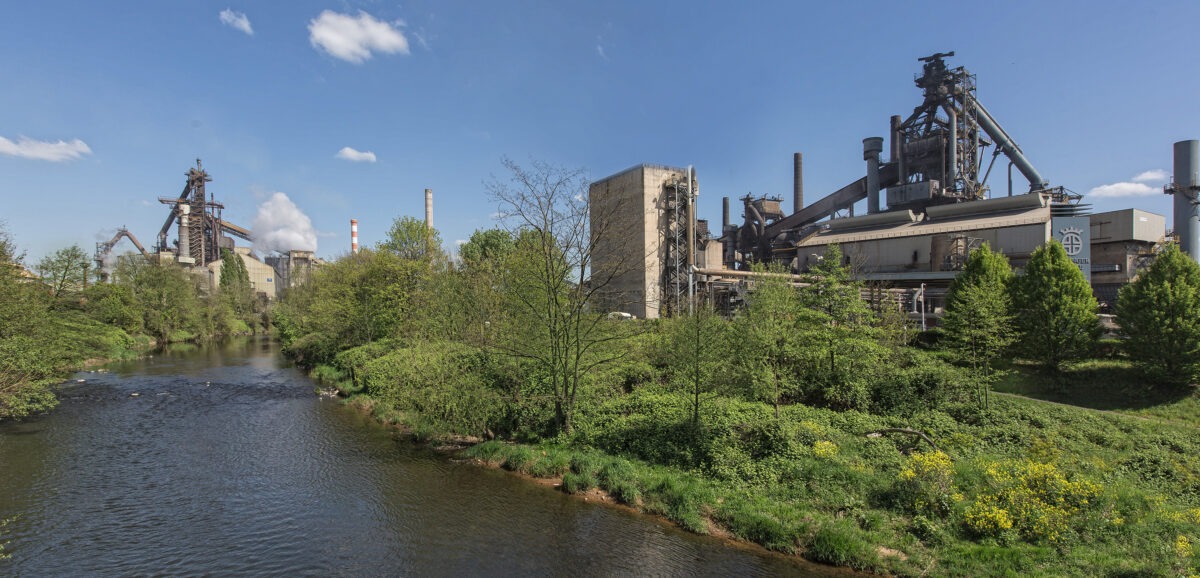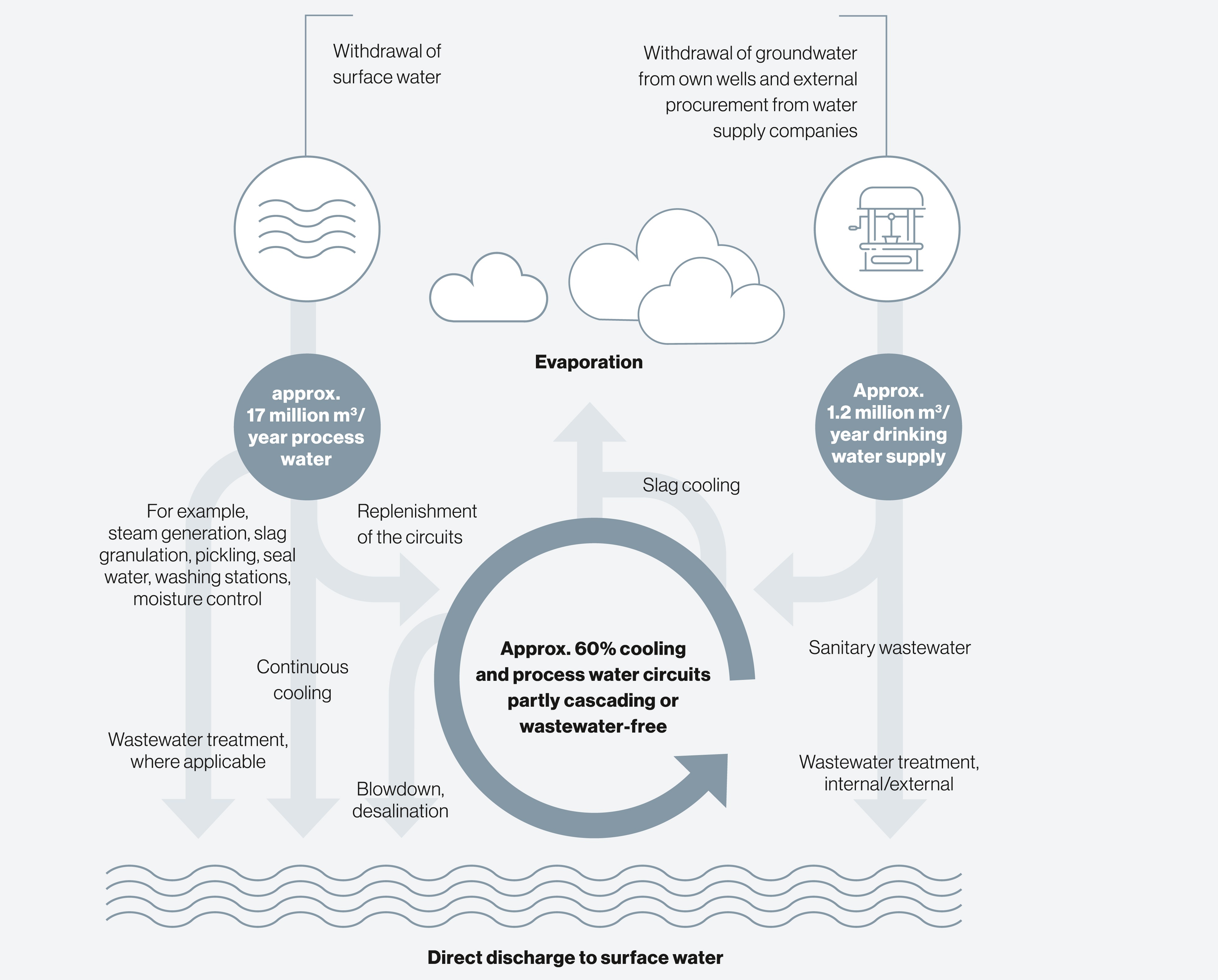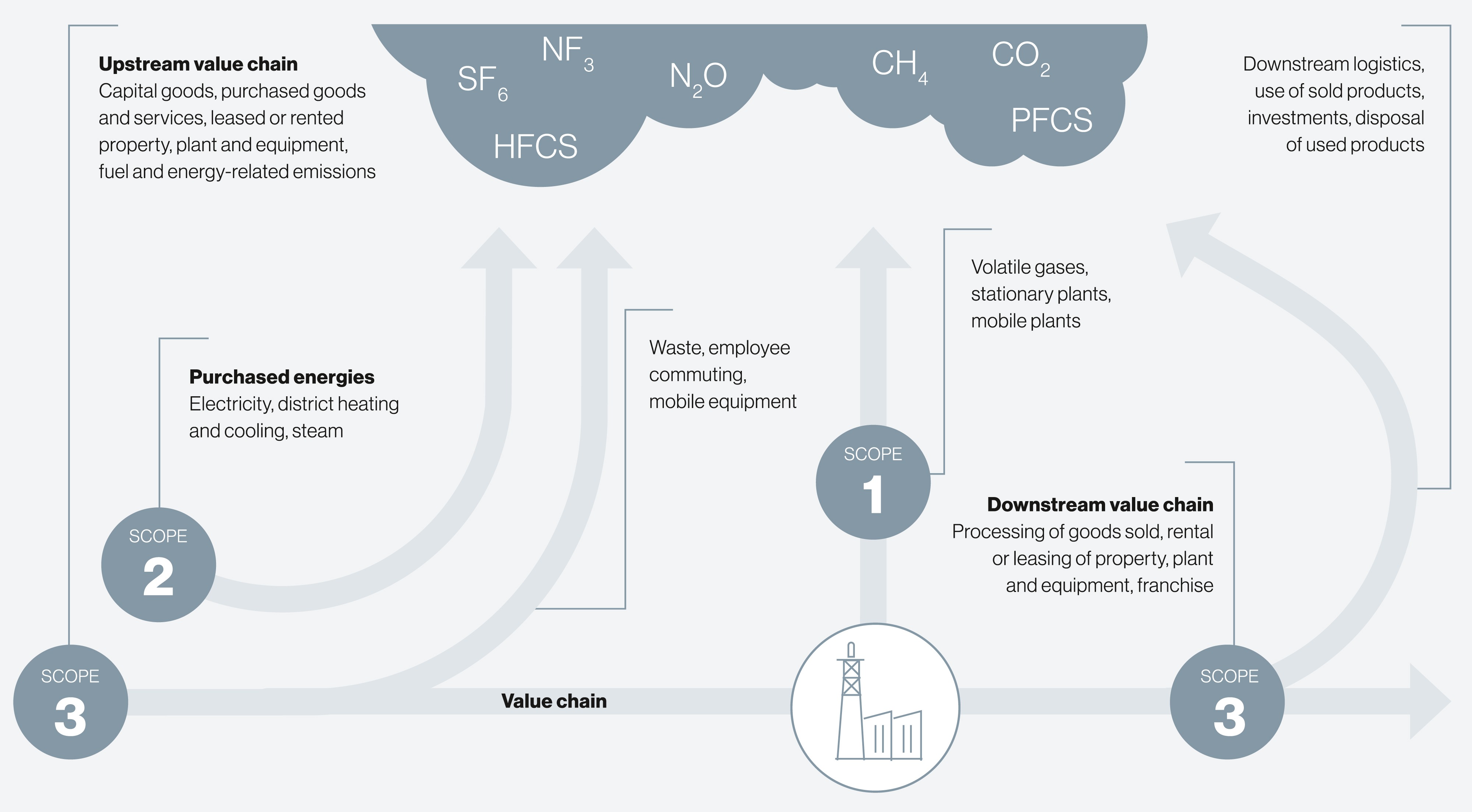Environmental
responsibility

Water management
The primary use of water resources is to cool production lines. We continuously strive for optimization through repeated use and the use of water-saving technologies. The majority of the required process and cooling water is circulated in closed circuits to minimize both water consumption and wastewater pollution. This intensive repeated use means that only a small proportion of the fresh water is released after purification into the environment as wastewater. Rainwater and leachate from landfills are also used in the processes. Due to their proximity to surface waters, our sites have several direct discharge points that are subject to strict environmental standards. At the Zentralkokerei Saar coking plant in Dillingen, we operate our own 3-stage biological wastewater treatment plant, whose wastewater sludge is completely recycled in the coking process. In addition to the efficient use of water, there is a special focus on protecting local surface waters in the vicinity of our production sites, which is a key responsibility in sustainable operations.
Air pollution control
In the field of technical environmental protection, it is crucial to reduce emissions from various sources and to improve air quality. The legal limit values, including Germany’s Technical Instructions on Air Quality Control (“TA Luft”), have recently been tightened.Dust
Dust
Comprehensive measures have been implemented in recent years to reduce dust, which has led to a significant reduction in dust loads over the last 10 years. One such measure was the installation at the Dillingen site of a dedusting system for the circular cooler at sinter plant 3 with heat recovery.
SO2
Sulfur dioxide emissions depend heavily on the quantity and quality of the coke oven gas used. Renovation of the coking plant’s high-pressure gas scrubbing system was an important measure for improving the coke gas quality and thus reducing SO2 emissions.
NOx
Introduction of new burner technologies has also reduced emissions of nitrogen oxides. However, the specific emissions can vary greatly depending on the product. Use of state-of-the-art exhaust gas cleaning technology and heat recovery will further improve the emissions situation at the sites in future through measures such as the implementation of a more efficient combustion air preheating system at the walking beam furnace in the Neunkirchen rolling mill.
Waste management
The circular economy and sustainable waste management are key measures for promoting sustainability in waste management. These concepts optimize material flows and make the use of raw materials more efficient. Our primary goal in operational waste management is to avoid waste, reduce its environmental impact, and minimize the amount of waste sent to landfill.
To achieve these goals, we rely on a waste management program that has been tried, tested and continuously revised over many years. This program is continuously adapted to changing legislation and customer requirements. SHS aims to make intelligent use of by-products and production residues and, where possible, to use them internally as substitutes for raw materials in order to conserve resources and reduce the burden on the environment.
If it is not possible to use a recycled material internally in our operating plants, we use external cycles in various branches of industry for material recovery.
Carbon Footprints@SHS
Corporate Carbon Footprint (CCF)
SHS compiles its corporate carbon footprint (CCF), which represents a comprehensive carbon input-output accounting of its direct and indirect greenhouse gas emissions at company level. The annual update of this accounting makes it possible to identify and make use of the potential for avoiding and reducing CO2 emissions. This reporting is performed in accordance with the DIN EN ISO 14064 standard and thus follows the Greenhouse Gas (GHG) Protocol. This protocol is of benefit to organizations, governments, project proponents and affected parties worldwide, as it provides clarity and consistency with regard to the quantification, monitoring, reporting, validation or verification of greenhouse gas accounting or mitigation projects. The qualitative determination and reporting of greenhouse gas emissions primarily includes the following emission sources:
Scope 1 – Direct greenhouse gas emissions from the operation of plant equipment:
- Use of input materials (coal, ores, scrap, aggregates, etc.)
- Fuel supply and consumption (natural gas, heating oil and liquid gas)
- Use of coolants
- Internal traffic and transportation
- Business trips with company cars
Scope 2 – Indirect energy-related greenhouse gas emissions:
- Supply of external power
- Purchase of district heating
Scope 3 – Additional indirect greenhouse gas emissions:
- Business trips (airplane and rental car)
- Upstream emissions of purchased fuels
- Emissions from the transportation of raw materials
- Commuter traffic of employees
- Capital goods
The SHS Group is continuously working to improve its Scope 3 reporting at company level.
Product Carbon Footprint (PCF)
SHS compiles product carbon footprints (PCF) to record the specific carbon emissions for the four main product groups of its Dillinger and Saarstahl brands: heavy plate, wire, rod, and rail. This concept follows emissions from a “cradle-to-gate” perspective, starting with the extraction of raw materials and ending with the finished steel product. All process steps are taken into account, from raw material extraction and transportation to the manufacture of primary products and the production of the end product.
The footprints are calculated as defined in the DIN EN ISO 14067 standard and the IPCC AR6 GWP100 standard. This differs from the CCF approach in particular when considering the individual scopes. The product-specific footprints are compiled using complex models that also take into account the interdependencies between the various production sites. The calculation according to the standard takes into account the usual credits for the physical allocation of the slag.
The calculation includes both direct and indirect, product-specific emissions from the main product groups and is based on
- Greenhouse gas emissions from the company’s own plants
- Emissions from the consumption of purchased energy
- Standard values from GaBi databases to determine upstream chain emissions (Scope 3)
Greenhouse gas emissions from the upstream chain
(Scope 3 – upstream)
As part of our analysis of the product carbon footprint, we have carried out a targeted calculation of the greenhouse gas emissions of our upstream chain. With the help of life cycle assessment software and the specific quantities of materials used, the SHS Group can show the upstream emissions on a product-specific basis. The dialogue with our suppliers and their commitment to reducing greenhouse gas emissions is of vital importance and will significantly help cut future emissions in the steel sector.
Product sustainability
In focus at Dillinger
We place particular emphasis on minimizing the impact of our products on the environment and society. We work hard to provide our customers with comprehensive information about the safety aspects of our products. This is done both through personal contact with our sales divisions and by providing information on our company website. This includes special letters on topics such as product sustainability, safety and the potential impact of ingredients. We provide information on various topics such as radioactivity, REACH, RoHS and CLP. In addition, safety data sheets are produced to ensure the safety of our customers. With regard to the supply chain, we also treat the topic of “conflict minerals” extremely sensitively. As far as possible, we ensure that no material is procured from conflict countries. As part of this, a guideline for conflict minerals has been drawn up.

